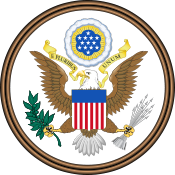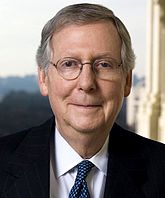- Party leaders of the United States Senate
-
Majority Leader of the
United States Senate
Democratic LeaderStyle Senator Inaugural holder Oscar Underwood Formation April 27, 1920 Minority Leader of the
United States Senate
Republican LeaderStyle Senator Inaugural holder Charles Curtis Formation March 4, 1925 This article is part of the series: United States Senate Members Current
(by seniority · by age · by class)
Former
Hill committees (DSCC, NRSC)
U.S. Vice President
President pro tempore (list)
Presiding officer
Party leaders and Assistants
Party leadership of
Democratic Caucus
the United States Senate
Republican ConferencePolitics and procedure Advice and consent
Closed session (list)
Cloture · Committees (list)
Executive session · Morning business
Filibuster · History · Quorum
Quorum call
Recess appointment · Salaries
Seal · Holds
Senatorial courtesy
Standing Rules · Traditions
Unanimous consent
VPs' tie-breaking votesPlaces United States Capitol
Senate Chamber
Senate office buildings
(Dirksen · Hart · Russell)United States 
This article is part of the series:
Politics and government of
the United StatesLegislaturePresidencyJudiciary
Other countries · Atlas
U.S. Government Portal
The Senate Majority and Minority Leaders are two United States Senators who are elected by the party conferences that hold the majority and the minority respectively. These leaders serve as the chief Senate spokespeople for their parties and manage and schedule the legislative and executive business of the Senate. By rule, the Presiding Officer gives the Majority Leader priority in obtaining recognition to speak on the floor of the Senate.
The Majority Leader customarily serves as the chief representative of his or her party in Senate, and sometimes even in all of Congress if the House of Representatives and thus the office of Speaker of the House is controlled by the opposition party.
Many state senates are organized in the same way as the United States Senate.
Contents
Current floor leaders
The Senate is currently composed of 51 Democrats, 47 Republicans, and two independents, both of whom caucus with the Democrats.
The incumbent floor leaders are Democratic Majority Leader Harry Reid of Nevada and Republican Minority Leader Mitch McConnell of Kentucky.
History
The Democrats began the practice of electing floor leaders in 1920 while they were in the minority. In 1925 the majority (at the time) Republicans also adopted this language when Charles Curtis became the first (official) Majority Leader[citation needed], although his immediate predecessor Henry Cabot Lodge is considered the first (unofficial) Majority Leader.
The Constitution designates the Vice President of the United States as President of the Senate. The Constitution also calls for a President pro tempore to serve as the leader of the body when the President of the Senate (the Vice President) is absent. In practice, neither the Vice President nor the President pro tempore—customarily the most senior (longest-serving) Senator in the majority party—actually presides over the Senate on a daily basis; that task is given to junior Senators of the majority party, in part so they may learn proper procedure. For these reasons, it is the Majority Leader who in practice manages the Senate.[citation needed]
List of party leaders
The Democratic Party first selected a leader in 1920. The Republican Party first formally designated a leader in 1925.
Congress Dates Democratic Leader Majority Republican Leader 66th 1920–1921 Oscar Underwood (AL) R Maj → Henry Cabot Lodge (MA) (unofficial) 67th 1921–1923 68th 1923 – November 9, 1924 Joseph Taylor Robinson (AR) 1925 Charles Curtis (KS) 69th 1925–1927 70th 1927–1929 71st 1929–1931 James E. Watson (IN) 72nd 1931–1933 73rd 1933–1935 ← D Maj Charles L. McNary (OR) 74th 1935–1937 75th 1937 – July 14, 1937 July 22, 1937–1939 Alben W. Barkley (KY) 76th 1939 1940 Warren Austin (VT) (acting) 77th 1941–1943 Charles L. McNary (OR) 78th 1943–1945 Wallace H. White Jr. (ME) (acting) 79th 1945–1947 Wallace H. White Jr. 80th 1947–1949 R Maj → 81st 1949–1951 Scott W. Lucas (IL) ← D Maj Kenneth S. Wherry (NE) 82nd 1951–1952 Ernest McFarland (AZ) 1952–1953 Styles Bridges (NH) 83rd January 3, 1953 – July 31, 1953 Lyndon B. Johnson (TX) R Maj → Robert A. Taft (OH) August 3, 1953 – January 3, 1955 William F. Knowland (CA) 84th 1955–1957 ← D Maj 85th 1957–1959 86th 1959–1961 Everett M. Dirksen (IL) 87th 1961–1963 Mike Mansfield (MT) 88th 1963–1965 89th 1965–1967 90th 1967–1969 91st 1969 – September 7, 1969 September 24, 1969–1971 Hugh Scott (PA) 92nd 1971–1973 93rd 1973–1975 94th 1975–1977 95th 1977–1979 Robert Byrd (WV) Howard Baker (TN) 96th 1979–1981 97th 1981–1983 R Maj → 98th 1983–1985 99th 1985–1987 Bob Dole (KS) 100th 1987–1989 ← D Maj 101st 1989–1991 George Mitchell (ME) 102nd 1991–1993 103rd 1993–1995 104th January 3, 1995 – June 12, 1996 Tom Daschle (SD) R Maj → June 12, 1996–1997 Trent Lott (MS) 105th 1997–1999 106th 1999–2001 107th January 3 – 20, 2001 ← D Maj January 20 – June 6, 2001 R Maj → June 6, 2001–2003[1] ← D Maj 108th 2003–2005 R Maj → Bill Frist (TN) 109th 2005–2007 Harry Reid (NV) 110th 2007–2009 ← D Maj Mitch McConnell (KY) 111th 2009–2011 112th 2011–Present Congress Dates Democratic Leader Majority Republican Leader See also
- Assistant party leaders of the United States Senate
- Party leaders of the United States House of Representatives
- President pro tempore of the United States Senate
References
- ^ Democrats remained in control after November 25, 2002, despite a Republican majority resulting from Jim Talent's special election victory in Missouri. There was no reorganization as Senate was no longer in session. Party Division in the Senate, 1789-present, via Senate.gov
External links
United States Senate Majority Leaders United States Senate Minority Leaders Categories:- Leaders of the United States Senate
- Lists of United States Senators
Wikimedia Foundation. 2010.




